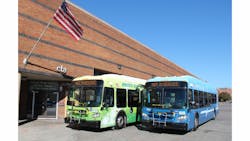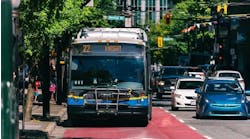The Chicago Transit Authority on Oct. 29 unveiled the first all-electric powered buses to be added to CTA’s fleet, as part of the agency’s efforts to modernize its entire bus fleet, which includes making CTA buses more efficient and environmentally friendly.
The two new buses will provide a cleaner, quieter ride that reduces fuel costs and significantly decreases emissions, improving air quality for customers and the general public.
“Adding all-electric buses to our municipal fleet of city vehicles is another way that we are building both a great city and a greener city at the same time,” said Mayor Rahm Emanuel. “These new electric buses will help move Chicago’s transit system into the 21st century and ensure that the City on the Move keeps moving forward in a way that protects our environment for future generations.”
The CTA announced in 2012 it would purchase two electric buses and hired New Flyer Industries Inc. for the $2.5 million project, which is funded by federal grants. The CTA is the first of any major U.S. transit agency to use all electric-powered buses as part of regular service. The electric buses are part of CTA’s ongoing modernization of its bus fleet announced by Mayor Emanuel in June 2012,complementing brand new clean diesel buses manufactured by Nova Bus that are currently being added to CTA’s fleet.
“We continually pursue the latest technology and innovation to improve service to CTA customers and reduce the agency’s costs,” said President Claypool. “These buses are our latest effort to go ‘green’, in addition to increasing the number of hybrid buses in our fleet, replacing old lighting with energy efficient LED lighting and recycling employee refuse and vehicle materials, such as oil, anti-freeze and batteries.”
CTA’s bus fleet upgrades since 2012 have included adding 300 new buses to replace buses purchase 2000-2002 and overhauling more than 1,000 buses that are seven to eight years old to extend their lifespans. About 15 percent of CTA’s buses are hybrid, which use a combination of electricity and clean diesel fuel). The CTA buses that are currently being overhauled will be more fuel efficient and emit fewer harmful emissions than when they were brand new.
Features and benefits of electric buses include:
- A much quieter ride. The noise produced by the new buses is about the equivalent to a human conversation.
- Lower harmful emissions – emissions from each bus is the equivalent of removing 23 cars from the road annually.
- Improves air quality, leading to fewer occurrences of illness and respiratory diseases, which is valued at approximately $55,000 annually per bus, or $660,000 over the expected 12-year bus lifespan.
- Saves the CTA more than $25,000 annually in net fuel costs per bus, or more than $300,000 over the expected 12-year bus lifespan.
The two new buses are the same size as CTA’s standard-sized 40-foot buses and will have the all of the same features, including a similar seat layout to existing CTA buses, a low-floor, ramp accessible design, a camera surveillance system and an Automatic Voice Announcement System (AVAS).
What’s different about these buses from the rest of the CTA fleet is that they will feature an all-electric propulsion system built by Siemens and that are powered with lithium-ion batteries. The buses can travel 80-120 miles on a single charge. Because of Chicago’s extreme winter temperatures, the buses have a small diesel heater that can be used in very cold temperatures for passenger comfort.
The buses have been rigorously tested for reliability and adaptability to extreme weather conditions, including their ability to heat and cool for passenger comfort. Their batteries also have safety features that preserve the battery by preventing it from being completely drained. The speed, acceleration and handling of the electric buses is equal to or better than buses in the existing fleet and also meets current industry performance standards.
The buses hit Chicago streets immediately and will be used on the No. 7 Harrison, No. 120 Ogilvie/Streeterville Express, No. 121 Union/Streeterville Express, No. 124 Navy Pier, No. 125 Water Tower Express, and No. 157 Streeterville/Taylor routes.



